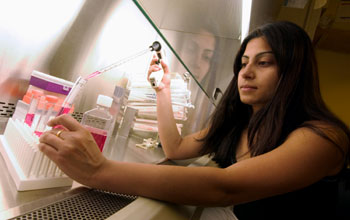Multimedia Gallery
Commandeering Cellular Machinery
Georgia Tech graduate student Priyanka Rohatgi tests whether the nuclear receptors engineered in yeast cells have the same function in mammalian cells.
Researchers have learned how to commandeer the complex machinery that cells use to recognize and respond to such important molecules as steroid hormones, thyroid hormones and vitamin D. The development could provide a foundation for a new family of biologically based mechanisms able to detect common drugs, chemical weapons and other small molecules. By allowing manipulation of this cellular protein machinery--known as nuclear receptors--the technique could also lead to new methods for producing enzymes and important pharmaceutical compounds. The work was sponsored by the Research Corporation, the Seaver Foundation and the National Science Foundation.
To learn more, see the Oct. 4, 2004, Georgia Tech Research News story, "Commandeering Cellular Machinery: Researchers Manipulate Recognition Mechanism to Detect Small Molecules." (Date of Image: October 2004)
Credit: Photo by Gary Meek; courtesy Georgia Tech
See other images like this on your iPhone or iPad download NSF Science Zone on the Apple App Store.
Special Restrictions: For editorial use only; not for advertising, commercial or for-profit use.
Images and other media in the National Science Foundation Multimedia Gallery are available for use in print and electronic material by NSF employees, members of the media, university staff, teachers and the general public. All media in the gallery are intended for personal, educational and nonprofit/non-commercial use only.
Images credited to the National Science Foundation, a federal agency, are in the public domain. The images were created by employees of the United States Government as part of their official duties or prepared by contractors as "works for hire" for NSF. You may freely use NSF-credited images and, at your discretion, credit NSF with a "Courtesy: National Science Foundation" notation.
Additional information about general usage can be found in Conditions.
Also Available:
Download the high-resolution JPG version of the image. (1.9 MB)
Use your mouse to right-click (Mac users may need to Ctrl-click) the link above and choose the option that will save the file or target to your computer.

